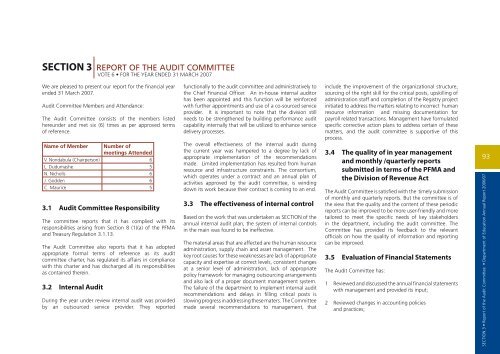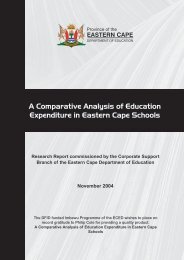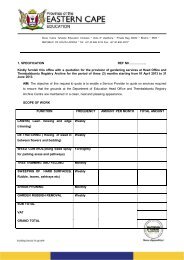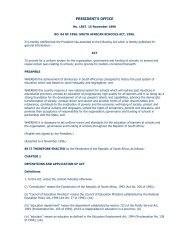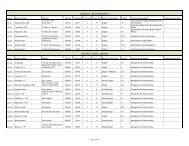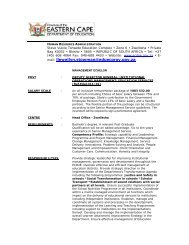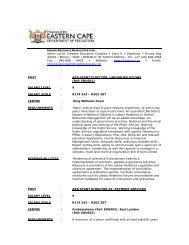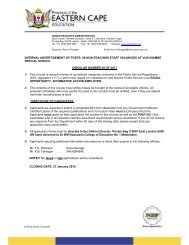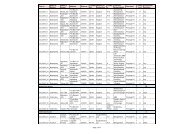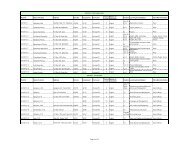Annual Report 2006/2007 - Department of Education
Annual Report 2006/2007 - Department of Education
Annual Report 2006/2007 - Department of Education
You also want an ePaper? Increase the reach of your titles
YUMPU automatically turns print PDFs into web optimized ePapers that Google loves.
SECTION 3 REPORT OF THE AUDIT COMMITTEE<br />
VOTE 6 • FOR THE YEAR ENDED 31 MARCH <strong>2007</strong><br />
We are pleased to present our report for the financial year<br />
ended 31 March <strong>2007</strong>.<br />
Audit Committee Members and Attendance:<br />
The Audit Committee consists <strong>of</strong> the members listed<br />
hereunder and met six (6) times as per approved terms<br />
<strong>of</strong> reference.<br />
Name <strong>of</strong> Member Number <strong>of</strong><br />
meetings Attended<br />
V. Nondabula (Chairperson) 6<br />
L. Dudumashe 5<br />
N. Nicholls 6<br />
J. Godden 6<br />
C. Maurice 5<br />
3.1 Audit Committee Responsibility<br />
The committee reports that it has complied with its<br />
responsibilities arising from Section 8 (1)(a) <strong>of</strong> the PFMA<br />
and Treasury Regulation 3.1.13.<br />
The Audit Committee also reports that it has adopted<br />
appropriate formal terms <strong>of</strong> reference as its audit<br />
committee charter, has regulated its affairs in compliance<br />
with this charter and has discharged all its responsibilities<br />
as contained therein.<br />
3.2 Internal Audit<br />
During the year under review internal audit was provided<br />
by an outsourced service provider. They reported<br />
functionally to the audit committee and administratively to<br />
the Chief Financial Officer. An in-house internal auditor<br />
has been appointed and this function will be reinforced<br />
with further appointments and use <strong>of</strong> a co-sourced service<br />
provider. It is important to note that the division still<br />
needs to be strengthened by building performance audit<br />
capability internally that will be utilized to enhance service<br />
delivery processes.<br />
The overall effectiveness <strong>of</strong> the internal audit during<br />
the current year was hampered to a degree by lack <strong>of</strong><br />
appropriate implementation <strong>of</strong> the recommendations<br />
made. Limited implementation has resulted from human<br />
resource and infrastructure constraints. The consortium,<br />
which operates under a contract and an annual plan <strong>of</strong><br />
activities approved by the audit committee, is winding<br />
down its work because their contract is coming to an end.<br />
3.3 The effectiveness <strong>of</strong> internal control<br />
Based on the work that was undertaken as SECTION <strong>of</strong> the<br />
annual internal audit plan, the system <strong>of</strong> internal controls<br />
in the main was found to be ineffective.<br />
The material areas that are affected are the human resource<br />
administration, supply chain and asset management. The<br />
key root causes for these weaknesses are lack <strong>of</strong> appropriate<br />
capacity and expertise at correct levels, consistent changes<br />
at a senior level <strong>of</strong> administration, lack <strong>of</strong> appropriate<br />
policy framework for managing outsourcing arrangements<br />
and also lack <strong>of</strong> a proper document management system.<br />
The failure <strong>of</strong> the department to implement internal audit<br />
recommendations and delays in filling critical posts is<br />
slowing progress in addressing these maters. The Committee<br />
made several recommendations to management, that<br />
include the improvement <strong>of</strong> the organizational structure,<br />
sourcing <strong>of</strong> the right skill for the critical posts, upskilling <strong>of</strong><br />
administration staff and completion <strong>of</strong> the Registry project<br />
initiated to address the matters relating to incorrect human<br />
resource information and missing documentation for<br />
payroll related transactions. Management have formulated<br />
specific corrective action plans to address certain <strong>of</strong> these<br />
matters, and the audit committee is supportive <strong>of</strong> this<br />
process.<br />
3.4 The quality <strong>of</strong> in year management<br />
and monthly /quarterly reports<br />
submitted in terms <strong>of</strong> the PFMA and<br />
the Division <strong>of</strong> Revenue Act<br />
The Audit Committee is satisfied with the timely submission<br />
<strong>of</strong> monthly and quarterly reports. But the committee is <strong>of</strong><br />
the view that the quality and the content <strong>of</strong> these periodic<br />
reports can be improved to be more user-friendly and more<br />
tailored to meet the specific needs <strong>of</strong> key stakeholders<br />
in the department, including the audit committee. The<br />
Committee has provided its feedback to the relevant<br />
<strong>of</strong>ficials on how the quality <strong>of</strong> information and reporting<br />
can be improved.<br />
3.5 Evaluation <strong>of</strong> Financial Statements<br />
The Audit Committee has:<br />
1 Reviewed and discussed the annual financial statements<br />
with management and provided its input;<br />
2 Reviewed changes in accounting policies<br />
and practices;<br />
93<br />
SECTION 3 • <strong>Report</strong> <strong>of</strong> the Audit Committee • <strong>Department</strong> <strong>of</strong> <strong>Education</strong> <strong>Annual</strong> <strong>Report</strong> <strong>2006</strong>/07


